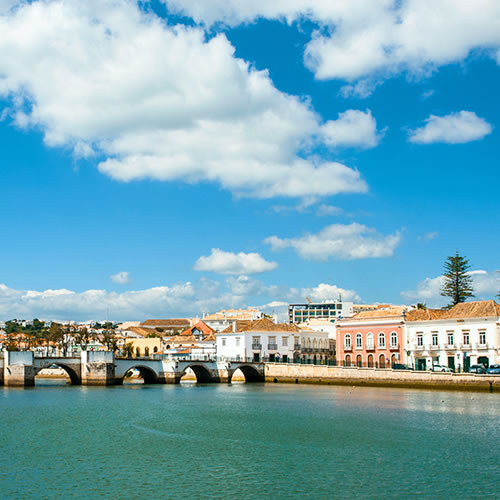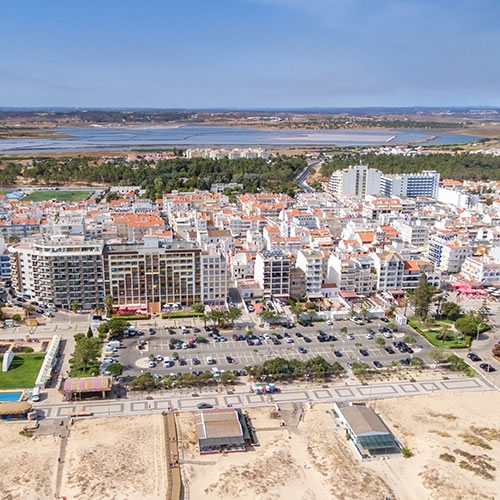ALGARVE EAST - TOWNS AND VILLAGES

Faro
With a population of approximately 45,000 in the city and an extra 15,000 in the suburbs, Faro is by far the largest city in the Algarve East, and one of the largest in the entire Algarve. (Portimao, adjacent to Praia da Rocha, is of similar size.) The town has been settled continuously since the fourth century before the Common Era, and it has been chartered as a town since the middle of the 16th century. Faro`s long, storied history can be seen everywhere in the city center, from the marina to the cathedral. During the time of the Moors, it was known as Ossanoba.
The city is located just north of the beaches and islands, which are part of the Ria Formosa Natural Park. The inner city of Faro is broken up into two sections: Se, which is the area surrounding the cathedral, and Sao Pedro, which was built outside the old `Muralhas de Faro` (Faro city walls) and served as an extension of the original city. Sights of note in Faro include, but are not limited to, Faro Cathedral, the Muralhas de Faro, Arco da Vila, Arco do Repouso, the Igreja do Carmo, and the Igreja da Misericordia.

Quarteira
Inhabited since the time of the Romans, Quarteira as we know it today was recognized as a town in 1916 and as a city in 1999. Vilamoura and Quarteira are essentially fused together, with Vilamoura being created from scratch, building up around Quarteira starting in the 1960s and 1970s. Including Vilamoura, the population of Quarteira numbers over 21,000. Originally an agricultural and marine economy, Quarteira`s fortunes are now strongly tied to the tourism industry.

Vale do Lobo
The 1.2-mile stretch of beach at Vale do Lobo has been popular with vacationers for decades, beginning in the 1960s when the country`s ruler at the time, Antonio de Oliveira Salazar, modeled Vale do Lobo after the resort Torremolinos in Spain`s Costa del Sol. In 1962, the Vale do Lobo Algarve Resort opened its doors, followed by the Dona Filipa Hotel in 1968. Two full 18-hole golf courses are located in Vale do Lobo, and it has hosted the Portuguese Open twice in the past.

Vilamoura
In the 1960s, Vilamoura (located inside the city boundaries of Quarteira) was developed by the Portuguese government as a resort which would ideally compete with Spanish-style resorts such as Torremolinos for foreign tourist dollars. The first golf course and resort opened in the area in 1965, and Vilamoura grew dramatically with the opening of the largest marina in Portugal in 1974. Today, Vilamoura consists of six golf courses, the aforementioned marina, two beaches, a major casino, and many luxury hotels. The Roman ruins at Cerro da Vila are also located in Vilamoura, to the northwest of the casino.

Tavira
The charter for the town of Tavira was first issued in 1520, making Tavira the oldest continuous settlement in the Algarve. Tavira (pop. 26,000) is located approximately 17 miles east of Faro, and about 16 miles to the west of the Guadiana River border crossing between Portugal and Spain.
Tavira has a long history, which includes being ruled by the Phoenicians, the Romans, the Moors, and finally the Portuguese. During Roman times, Tavira grew as a stop on the trading road between Balsa (now Luz de Tavira) and Baesuris (now Castro Marim). Sights of interest in Tavira include Igreja do Santiago, Tavira Castle, and the Roman bridge of Tavira. Believe it or not, the Roman bridge of Tavira was actually an undertaking overseen by the Moors.

Altura
Altura (pop. 2,500) is one of the four parishes in the town of Castro Marim. While other areas of the Algarve can be seen as overly developed and catering almost exclusively to tourists, Altura is a quiet resort town where tourists mingle happily with friendly locals. Three miles away, there is the resort town of Monte Gordo which is a bit more bustling and has lots of activity, day and night.

Monte Gordo
Fewer than two and a half miles from the Spanish border is the resort town of Monte Gordo (pop. 3,300). Originally a place for Portuguese vacationers to enjoy fun in the sun during the summer months, it has slowly but surely become a popular destination for people visiting from outside the country. The sands at Monte Gordo Beach are nearly white, and the waters here are among the warmest in the Algarve, due to the flow from the Mediterranean Sea into the Gulf of Cadiz.
The nearest town to Monte Gordo is Vila Real de Santo Antonio, located on the Guadiana River two miles east. It is the last town in the eastern Algarve before reaching Spain, and it is the last Portuguese railway stop before crossing the border (trains from Faro will travel on to Huelva).